Xylophanes pistacina
Xylophanes pistacina
zail-AH-fan-eesmmpis-tah-SEE-nuh
(Boisduval, [1875]) Philampelus
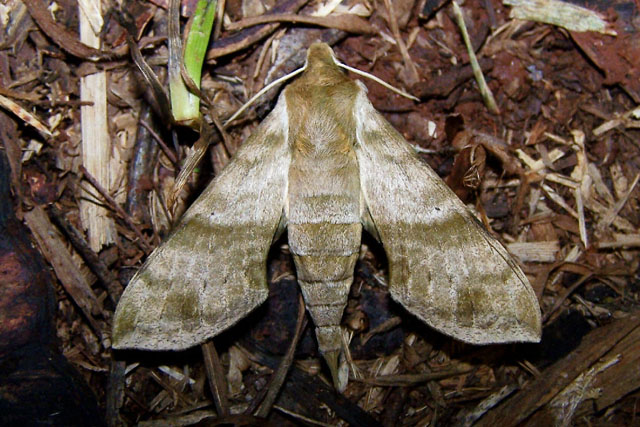
Xylophanes pistacina, Paraguay, courtesy of
Ulf Drechsel.
This site has been created by
Bill Oehlke at oehlkew@islandtelecom.com
Comments, suggestions and/or additional information are welcomed by Bill.
TAXONOMY:
Family: Sphingidae, Latreille, 1802
Subfamily: Macroglossinae, Harris, 1839
Tribe: Macroglossini, Harris, 1839
Genus: Xylophanes Hubner [1819] ...........
Species: neoptolemus Boisduval, [1875]
|
MIDI MUSIC
.....It's a Wonderful World.....
copyright C. Odenkirk
ON.OFF
<bgsound src="world.mid" LOOP=FOREVER>
|
DISTRIBUTION:
Xylophanes pistacina moths
(wingspan: 75 - 87 mm) fly in Brazil (specimen type locality) and
generally from Nicaragua (JH - indicates this species is not taken
north of Nicaragua) south to Brazil, west to
Bolivia: La Paz: Murillo, Río Zongo, (750m),
Santa Cruz;
Paraguay: San Pedro, Canindeyu, Alto Parana,
Cordillera, Paraguari, Caaguazu, Guaira, Caazapa, (probably
Itapua (WO??);
Argentina: Misiones (ENB).
Jose Monzon reports it in Guatemala: Izabal.
"Upperside of abdomen without lines.
Ground colour greenish-buff, but variable, some individuals much greener. Subbasal and antemedian lines vestigial, the two distal ones forming a band at the apex of
discal cell, angled at CuA1; the two proximal postmedian lines more or less merged to form a band, the inner often straight; the third postmedian line very faint;
the fourth more distinct and emphasized by vein dots; postmedian lines 2 to 4 dentate; postmedian line 5 curved from the wing apex and continuous with a greenish olive
patch from M2 to M3.
Brown border broad, less angulate posterior to M2 than in Xylophanes schausi.
Pale hindwing band highly suffused with olive-brown." CATE
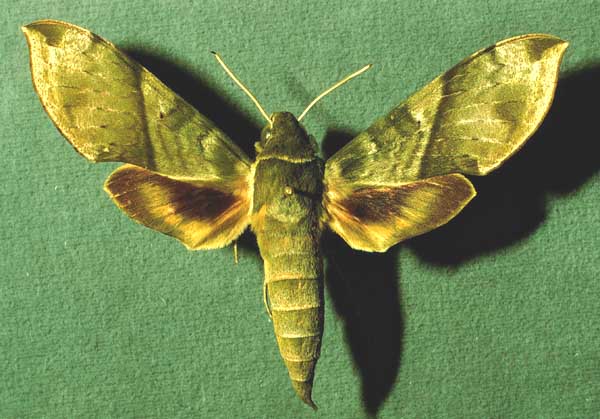
Xylophanes pistacina male, Costa Rica, courtesy of Dan Janzen.
FLIGHT TIMES:
Xylophanes pistacina adults fly
all year in Costa Rica.
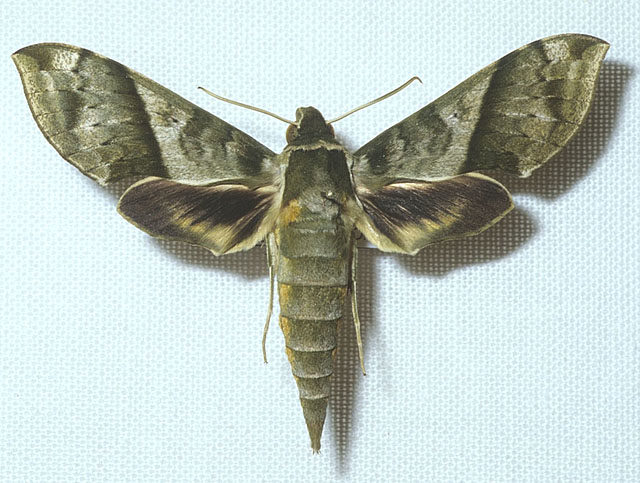
Xylophanes pistacina male, courtesy of
Hubert Mayer
copyright.
ECLOSION:
Pupae probably wiggle to surface from subterranean chambers or leaf
litter just prior to eclosion.

Xylophanes pistacina female courtesy of Dan Janzen.
SCENTING AND MATING:Females call in the males with a pheromone released from a gland at the tip of the
abdomen. Males come in to lights very readily, but females are
seldom taken in that way.
EGGS, LARVAE, PUPAE:
Larvae feed on
Psychotria in the Rubiaceae
plant family.
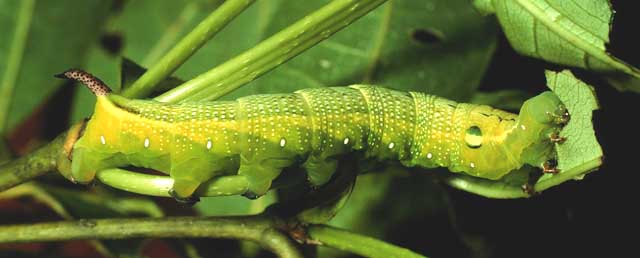
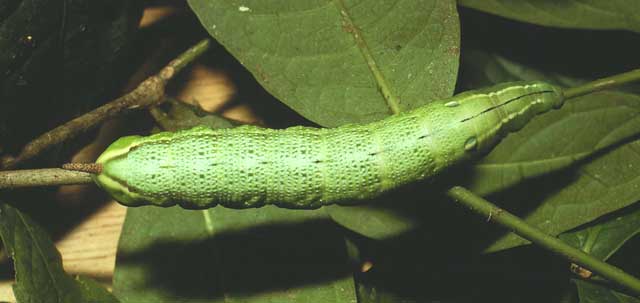
Xylophanes pistacina larva courtesy of Dan Janzen.
Moths emerge approximately one month from pupation date.
Use your browser "Back" button to return to the previous page.
Goto Main Sphingidae Index
Goto Macroglossini Tribe
Goto Central American Indices
Goto Carribean Islands
Goto South American Indices
Goto U.S.A. tables
The pronunciation of scientific names is
troublesome for many. The "suggestion" at the top of the page is
merely a suggestion. It is based on commonly
accepted English pronunciation of Greek names and/or some
fairly well accepted "rules" for latinized scientific names.
The suggested pronunciations, on this page and on other pages,
are primarily put forward to assist those who hear with internal
ears as they read.
There are many collectors from different countries whose
intonations and accents would be different.
Jean Marie Cadiou writes, "When I say "Xylophanes" in English I
pronounce it something like "Zailophanees", with the emphasis on the
"o". The French pronounce it differently, something like
"Kzeelophaness" with no emphasis, and the Germans yet in a
different way..."
In Greek myth, Phanes is the golden winged Primordial Being who
was hatched from the shining Cosmic Egg that was the source of the
universe. He personifies light emerging from chaos.
"Xylo" is the Greek word for wood.
The specimen type for the genus
Xylophanes is Xylophanes anubus. Perhaps ? when Hubner
examined that species, the yellow-orange and brown tones of the
forewings suggested wings of wood.
I have no idea regarding the source
of "pistacina".





